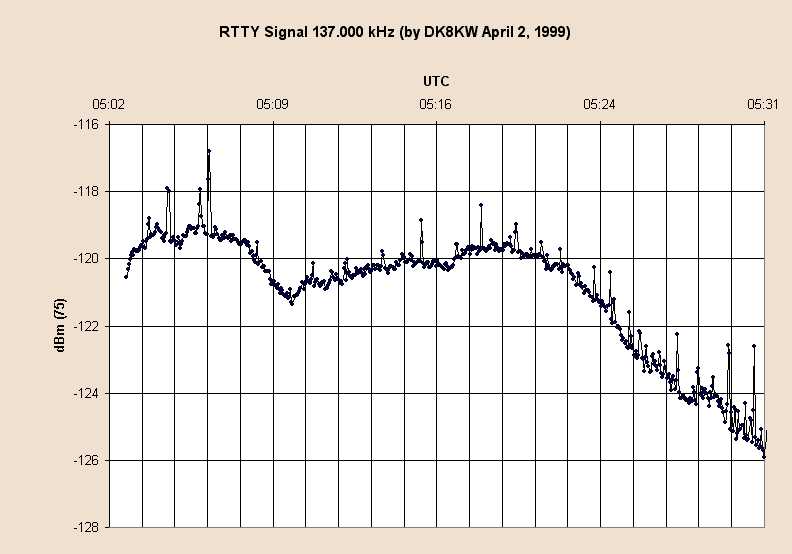
The signal appears in the night with the following parameters:
Mark: 136.949 kHz
Space: 137.025 kHz
Shift: +/- 42.5 Hz
Baudrate: 100 Bd (?)
Signal strength: up to -84 dBu (at 75 Ohm),
completely disappearing at sunrise (see graph)
Direction of signals: not yet measured
Origin of signals: CFH in Halifax (MN14XX)
>Thanks to Jon VE1FTL I have the following interesting details on the
system
>at CFH. Jon says it is a Canadian Naval site and gives the location
as
>Newport Corner.
>
>The transmitter is aging valve unit, capable of 25KW, but more usually
run
>at 8 to 9 kW.
>Modulation is FSK +/- 42.5Hz from the nominal carrier. This power
>corresponds to 30 to 40 Amps into the aerial, which is what I think
would be
>called an 'umberella' . The main radiator is about 600 feet tall (Jon
hadn't
>he exact dimensions to hand) It is capacitively loaded with
a system
>consisting of the top 25% of each of the six guy spans with the ends
>connected together by a circle of wire, and then 6 more wires running
from
>the top to the this circular wire. Sounds a bit like the big brother
of the
>systems Dick was modelling a few weeks back.
>
>The station is off the air for maintenance and will not return until
the
>Navy requests it. The transmitter is to be replaced by a more modern
>solid-state class C unit some time early next year.
>
>I guess there is enough detail there for some of you guys to estimate
the
>ERP. Ok we dont know what the losses are but I reckon we could make
a
>reasonable guess.
>
>The plus point on this is that the aerial is about what I had though
it
>might be, but the power is a lot less (I thought it might be a 50kW
unit) so
>the margin needed to hear a amateur signal might not be so great.
Of course
>the 'answer's in the soil' !!
>
>Once again this is all thanks to Jon, ( who is a technician on the
site )
>who has promised to e-mail me when it is due to return to the air.
>
>73 de Alan G3NYK
>Alan.Melia@btinternet.com
>Halifax is the administrative centre and naval port. The actual
>transmitter site is in the village of Newport Corner, about 40 km
WNW of
>Halifax, at 44 deg 58 min North, 63 deg 59 min West.
>Best regards, Jon - VE1FTL
>CFH also has a LF weather broadcast on 122.5 kHz which consists of
>RTTY bulletins and weather maps in FAX format. If this particular
>transmitter or its associated aerial were down for maintenance, it
is
>likely that the weather broadcast was "patched-over" to the 137 kHz
>transmitter to maintain continuity. A rare occurence, but it
has been
<done in the past.
>
>73, Jon - VE1FTL
>ve1ftl@chebucto.ns.ca
The station was heard throughout Europe but also in the North-Eastern part of the US.
137.000 kHz RTTY Signal fading out (April 2, 1999, 05:00-05:30 UTC)

Alan, G3NYK, made the following observation on the signal strength behaviour of this station:
---I left my receiver running into FFTDSP4 at Friday midnight, with
the longterm monitor storage enabled (by about 1000Z on Saturday it had
accumulated a 24 meg file) The 137.0 RTTY signal was not apparent when
I went to bed at about 2330Z. It appeared on the screen at about
0015Z and was quite strong between 0100Z and 0330Z with a peak in strength
at about 0300Z. During this part of the night (well morning I suppose)
there was a steady background 'crackle' like distant storm activity. At
its strongest it was reading 20dB S/N on FFTDSP's 'measuement'. This is
about the same as I see for the strongest G stations in good conditions.
There is a noticable decline to 0330Z with a marked reduction in the background
noise. By 0340Z it was down to 10dB S/N and by 0400 it had totally disappeared
from the screen to background noise virtually disappeared at the same time.
An interesting point was that the signal faded into the noise for several
minutes then rose out of the noise again for about 5 minutes and then faded
away all together. This reminds me of the way I have heard the HF bands
close to DX when I used to be more active up there. I have not yet investigated
the Grey-line for 10th/11th June but I suspect that this may explain why
we are not hearing the Halifax N.S. (??) station as much as we used to
earlier in the year. (just for identification purposes I make the shift
about 75-80Hz in the 2Hz resolution mode of FFTDSP)
Unfortunately I am unable to log signal strength as only the lightning
crashes move the s-meter using my passive loop. As an indication of my
sensitivity, I could see DF2PY (136.9 kHz) on my screen on Sat morning
at about 6dB S/N but I could not copy his morse. I know it was him from
the Cluster spot he put up and I think PA0LQ worked him later.
General activity seemed to start about 0515Z, with the first qso I
observed at about 0524Z.
In conclusion this observation would suggest that the best time for
Transatlantic QSOs would be about half an hour before dawn ( I dont know
whether that is the visible dawn or a sort of 'radio' dawn) It looks like
we will need some insomniacs to work the States.
I understand the AMRAD beacon is operating now.....is it on 136.75??
as was projected.
I will try to set up some signal strength logging, but also calibrate
the sensitivity of my loop aerial.
Hope that was interesting
Cheers de Alan G3NYK
Alan.Melia@btinternet.com
